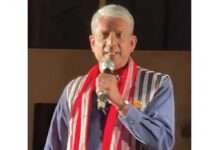[S Mundayoor]
In the previous article (‘Television for education…’, etc, dated 19 June, 2020) we saw some experiences which showed that learning for any age group can become more lively and meaningful when TV becomes an active partner to the teacher and the learner, with imaginatively prepared, well-delivered audiovisuals.
Our own observations show how a learner consciously chooses to accept or ignore different modes of learning, be it classroom teaching or TV telecasts. Hence it is vital that when we introduce educational TV telecasts, they should be lively and motivating to the viewer and promote understanding by relating to his/her previous knowledge or life.
An excellent example is the learning of Hindi during the 1950s to the ’80s by the adult population in Kerala and Tamil Nadu. Even though reading and writing of Hindi were taught in Kerala’s schools from the 1950s, the students had hardly any listening and speaking skills as no need existed for their use. It was only in the late 1980s that regular screening of Sunday Hindi films by DD, and later the Ramayana and the Mahabharata series, encouraged and substantially enabled the adult population to master listening comprehension of Hindi. They started practising speaking skills only when there was a large-scale migration of labour in the late ’90s from central and eastern India.
This is very relevant when we remember that the majority of rural Arunachalee students have inadequate exposure to spoken English, even though it is our medium of instruction since 1972. Lively TV shows can substantially promote English language listening and speaking skills, as we see from the Disney Cartoon TV experiences.
So what can Arunachal do to promote learning – nay, the joy of learning – among our students during these Corona days? And how could we use TV and radio in school education? Prudence always calls for looking up to successful models. Let’s look at a few of them.
Victers Channel of Kerala govt
Since 2001, the IT education programmes of the Kerala government have been channeled through an independent TV channel, offering programmes for Classes 1 to 12 in the local Malayalam language for over 12,000 schools, covering five million students. It also provides the content in English for English medium schools.
During the Corona pandemic, Victers Channel came to the limelight when it started the ‘First Bell’ online classes for all 12 classes on TV channel and on online platforms. The channel telecasts content for 17 hours daily.
Meticulous and enthusiastic participation by public leaders and legislators have made the classes accessible even in remote villages, either on TV (often in a library or community hall) or by providing each student a mobile or a tablet.
Balchitravani of Maharashtra govt
Launched in 1984, it was one of the most popular free educational TV programmes in the country for a long time, till it got suspended. Realizing the present urgent need, the Maharashtra government has decided to relaunch Balchitravani.
Like in Kerala, the success of the programme is because of the use of mother tongue extensively in school education, along with English.
Central Institute of Educational Technology
A unit of the NCERT since 1984, the Central Institute of Educational Technology promotes utilization of technology for educational enhancement of schools. It has a huge library of audiovisual resource materials, some of which are being disseminated through the Swayam Prabha TV channel and cable operators. It has also the National Repository of Open Educational Resources, from which Arunachal could benefit immensely.
British Council
A pillar of the growth of English education in the country, the British Council has also contributed to building a cadre of proficient language teachers. The British Council establishments in the metros have also been supporting institutions and learners by lending ELT films and now videos.
During the mid-1980s, this writer was involved in screening the British Council’s delightful language drill films in Arunachal’s schools. It also has a website, www.teachingenglish.org.uk, with freely downloadable videos, practice lessons and language exercises.
Since the Arunachal government has already an agreement with the British Council, it would greatly benefit if we can get suitable videos and audios from them to help students and teachers develop correct pronunciation and reading skills.
English & Foreign Languages University, Hyderabad
The erstwhile Central Institute of English and Foreign Languages, now called the English & Foreign Languages University (EFLU), has had a long association with Arunachal since the ’70s, when we had been using their ‘Let’s learn English’ series in schools from Classes 1 to 8. Who could ever forget ‘Kutchu and his Glasses!’
The EFLU has also a large repository of ELT audio materials for practising pronunciation, intonation, etc. The state could also benefit from the expertise of several experienced professors who, though retired, still cherish warm feelings for Arunachal and its youth.
Educational toy wizard Arvind Gupta
An engineer by background, Arvind Gupta is a decorated teacher-trainer of popular science and the creator of the amazing website www.arvindguptatoys.com, a treasure trove of delightful videos, films, DIY science experiments, toys, puzzles and rare books on maths, science and education.
Some of his classic videos have been screened in several teachers’ training programmes in Lohit, Anjaw, Dibang Valley and Namsai districts. The education department could greatly benefit from associating with Arvind Gupta and his website in the state’s learning enhancement programmes. His sessions could greatly boost any learner’s motivation.
All India Radio
Several AIR stations, like AIR Mysore, have produced excellent school programmes in different state languages, including English. Hence AIR’s highly professional broadcasters could be of great support to train our teachers in the skills of broadcasting.
How to use these prerecorded audio/video content?
Till Arunachal has professionally trained broadcasters, it is advisable to use already proven audiovisual content from any of these sources.
They need not be a text lesson, but help learners to develop the concepts related to that. When prerecorded content is thus being used in a telecast, the session should invariably also include a local qualified teacher. He/she is to connect the listeners to the content. He/she could, at the end of the show, offer any explanation needed for the students and raise queries to them. Ideally these sessions should also have some students/dummy students. Addressing an imaginary student in the recording studio would be an uneasy experience for the speaker as well as the listeners outside.
The coronavirus has indeed presented all of us with an opportunity for some creative thinking, for the good of the youth of Arunachal. It is earnestly hoped that the learned education minister and the administrators would plan effective strategies to provide our students with a creative new exposure to the joy of learning through TV and radio, even after the schools open. (S Mundayoor is an education and library activist with four decades of close association with the Arunachalee youth. He is the coordinator of the Lohit Youth Library Network and the academic advisor to RIWATCH, Roing. Email: lohit.libraries@gmail.com.)


